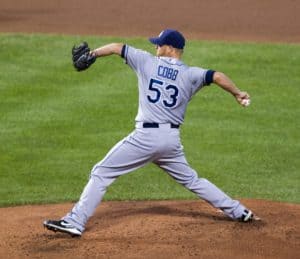

Photo by Keith Allison
It seems destined that the Phillies will add at least one starting pitcher for 2018. While we’ve heard quite a few names associated with the Phils, perhaps no pitcher has been more rumored to be targeted by the club than Alex Cobb, a free agent who has spent his career with the Tampa Bay Rays.
So let’s talk about this.
First, here’s what we know about Cobb and the market: The Cubs reportedly offered him a three-year, $42 million contract, and Cobb declined. Apparently Cobb is seeking $20 million per season. There are whispers he’d accept something like four years and $70 million, so we’re talking one more year and an average annual value of $17.5 million.
Now let’s put the Phillies in this discussion, because plenty people still believe they’ll end up with Cobb. We know the Phils don’t mind spending right now, if they believe the value is worth the risk. So before we talk money, is Cobb worth the risk?
Cobb missed all of 2015 and most of ’16 with a UCL tear, leading to Tommy John surgery. So let’s look at his standard rate numbers from 2012-’14 and then ’16-’17:
It’s hard to even consider 2016, but here, Cobb’s post-Tommy John numbers are showing a different pitcher than pre-Tommy John Cobb. The strikeout numbers have dropped off while the fly-ball rate, and consequently the home run rate, has increased. The walk rate has seemed to drop, however, which is good. Ultimately, it seems as if Cobb is pitching to contact more.
Let’s look at Cobb’s arsenal. Between 2012 and ’14 he threw the fastball about 43 percent of the time. But he ramped that up to 51.5 percent last year. He also threw the curveball a lot more – from 2012-’14 he tossed it about 20 percent of the time, but last year, 34.1 percent. He dramatically decreased the usage of his most distinctive pitch, the splitter (also considered a changeup or split-change) from an average of 35 percent to 14.4 percent.
This is well known. Analysts have written about the decrease of the splitter usage. This Beyond the Box Score piece does a great job explaining what happened – basically, since Tommy John he’s relied less on it because he said it takes longer to get a feel for it. It doesn’t drop like it used to, either, which is one reason that fly-ball rate is higher.
That said, the same Beyond the Box Score piece found his curve was picking up the slack. Despite the curve being hit relatively hard, most hitters were getting under it too much, limiting home run damage.
So despite Cobb nearly becoming a two-pitch pitcher in 2017, he was still quite effective.
But here’s the deal. Citizens Bank Park had the highest home run factor in baseball in 2017, its 1.409 (1.4 times more likely to generate home runs than the average park) far above even second place Yankee Stadium (1.279). Cobb’s Tropicana Field had a 0.888 home run factor, 22nd in baseball.
Cobb of course had to pitch in Yankee Stadium and Oriole Park at Camden Yards (1.236), but Fenway (0.824) and Rogers (0.923) have low home run factors. In the NL East he’d also pitch more often at relatively poor home run parks: SunTrust (0.951), Marlins (0.835) and Citi (0.798). Even with those lower numbers, let’s be real: Cobb will be tested far more often to keep the ball in the yard in Philadelphia.
That’s not necessarily a dealbreaker, because we can’t look at just one consequence of Cobb’s new approach. But it does raise a major question that the Phils – more than other teams – have to take seriously: Can Cobb’s splitter return to being at least a plus pitch?
A two-pitch pitcher (essentially) – even one who skillfully uses that second pitch – is a big risk for $18-$20 million per year. It’s a big risk for three or more years. But while some teams (like the Cubs) are more suited to take the risk, the Phillies – with a park that allows more home runs, plus more questions about the rotation and other areas – may not be best. You could definitely pencil him in as a No. 4 quality starter, maybe a No. 3, but as a No. 2? Can’t do that for three to four years.
So is it worth it for the Phils to get Cobb for three years and $60 million, or four years and around $75 million? There’s more risk than perceived with Cobb.